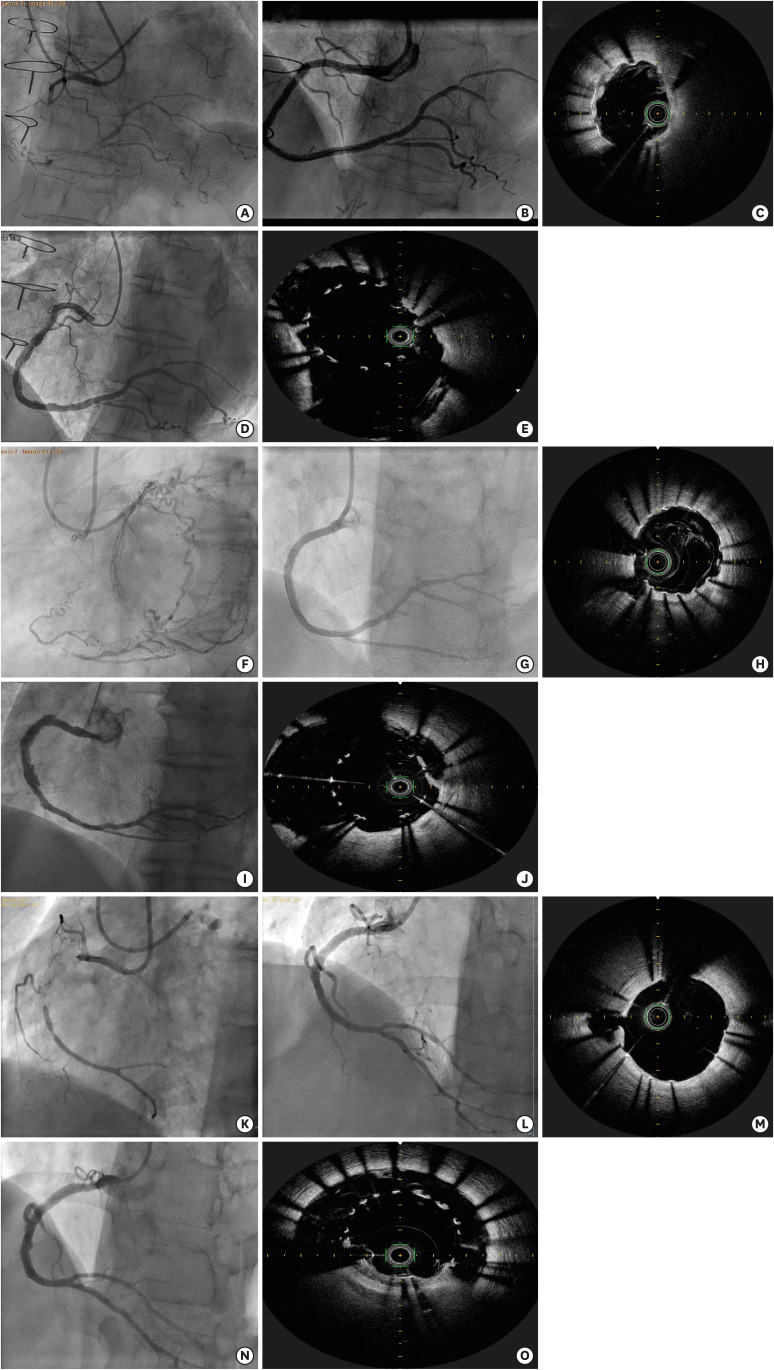 | Figure 1(A, F, K) Right coronary artery with proximal chronic total occlusion. (B, G, L) Immediate perfect angiographic result after successful CTO PCI using the reverse CART technique. (C, H, M) Immediate OFDI result. Stents are well apposed everywhere. Some struts are deeply impacted in the media which seems to be heterogenous (thrombus, haematoma or scar of dissection?). (D, I, N) One-month systematic angiographic control showing several aneurysms in the reverse CART target zone (arrows). (E, J, O) One-month systematic OFDI control showing large and circumferential acquired stent malapposition. Stents are perfectly deployed without underexpansion (mean diameters are equal to the initial stent size, A4 SMD: 3.6 mm; B4 SMD: 3.6 mm; C4 SMD: 4.1 mm). Stent struts appear to be free of thrombus or neoendothelium. The vessel lumen area increased abnormally with a mean diameter compatible to acquired shredding aneurysms (A4 LMD: 6.2 mm; B4 LMD: 5.9 mm; C4 LMD: 5.4 mm).CART = Controlled Anterograde and Retrograde Tracking; CTO = chronic total occlusion; LMD = lumen mean diameter; OFDI = Optical Frequency Domain Imaging; PCI = Percutaneous Coronary Intervention; SMD = stent mean diameter.
|
The pathobiology of chronic total occlusion (CTO) is complex.1) In such lesions, 4 arterial zones (lumen, intimal plaque, media, adventitia) are reached by substantial inflammatory processes, and each layer is equally affected.2) In some cases, stents for recanalization are partially in an extraluminal-intramedial position, and the specific evolution and endothelization have not been studied. We report here 3 cases for which a CTO Percutaneous Coronary Intervention has been performed with reverse-Controlled Anterograde and Retrograde Tracking (CART) techniques by 2 expert operators with an unusual aneurysmal evolution (Figure 1). The stent did not appear to be undersized with a classic late acquired stent malapposition. We know that after a CTO procedure, the mean artery diameter increases by a small percentage, especially in its distal portion.3) Here, the “lumen” artery increased by more than 100%, and each time, it occurred in the reverse CART target zone. Two combined options could probably explain the aneurysmal evolution. First, the reverse CART technique with large knuckle wires created a media hematoma that could partially or totally disappear several weeks after stenting. Second, due to a lack of constrained elastic tunics, the blood pressure flow shreds the media. The walls are no longer held by a consistent media or elastic tunics, and thus, they become aneurysmal: a progressively shredding acquired aneurysm of the neo-lumen without variation in the adventitia diameter. Therefore, each complex revascularization of CTO should be controlled, with intravascular optical coherence tomography if necessary.
References
1. Galassi AR, Sumitsuji S, Boukhris M, et al. Utility of intravascular ultrasound in percutaneous revascularization of chronic total occlusions: an overview. JACC Cardiovasc Interv. 2016; 9:1979–1991. PMID: 27712732.
2. Srivatsa SS, Edwards WD, Boos CM, et al. Histologic correlates of angiographic chronic total coronary artery occlusions: influence of occlusion duration on neovascular channel patterns and intimal plaque composition. J Am Coll Cardiol. 1997; 29:955–963. PMID: 9120181.
3. Jia H, Hu S, Liu H, et al. Chronic total occlusion is associated with a higher incidence of malapposition and uncovered stent struts: OCT findings at 6 months following DES implantation. Catheter Cardiovasc Interv. 2017; 89:582–591. PMID: 28318139.

Go to : 




 PDF
PDF Citation
Citation Print
Print



 XML Download
XML Download